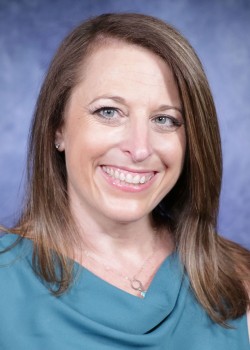
Andrea Warner-Czyz
Research Interests: Exploring how infants, children, and adolescents with hearing loss, who wear cochlear implants, learn to communicate with others, and how communication affects how they feel about themselves
972-883-3124
CR 1.510
The CHildren and Infant Listening Laboratory (CHILL)
Chill Lab Facebook
Curriculum Vitae
Professional Preparation
University of Texas at Austin - 2005
University of Florida - 1996
Research Areas
Research Interests
The overarching goal of Dr. Warner-Czyz's research is to understand how speech perception emerges in infants and children with hearing loss, particularly those who receive cochlear implants. Her current research projects focus on the effect of reduced spectral resolution, such as that received through a cochlear implant, on infants' ability to discriminate two sounds - a very early speech perception skill that depends on the ability to recognize patterns in the speech. One primary approach she uses to examine this area is present a cochlear implant-simulated signal to infants with normal hearing to see how well they discriminate degraded speech. Although cochlear implant devices restore the sensation of hearing to individuals with significant levels of hearing loss, the signal is degraded relative to spectral resolution. Reduced resolution of spectral cues creates difficulty perceiving cues in speech sounds such as syllables, words and sentences. This task may be more difficult for infants and children who have less experience with language input relative to adults, and therefore less ability to develop top-down processing skills to "fill in the gaps" when a signal is distorted. Recent research projects center on the effects of infant age, stimuli type and level of spectral resolution (i.e. number of spectral channels) on infants' ability to discriminate speech sounds. Results support a multi-factorial approach to emergence of early perceptual skills and have implications for clinical monitoring and setting realistic expectations for the development of speech perception by infants with hearing loss who receive cochlear implants. This research has been supported by grants from the North and Central Texas Clinical Science and Translational Initiative and the American Academy of Audiology Foundation. A secondary research interest involves exploration of how cochlear implantation impacts quality of life in children and adolescents with cochlear implants. This quality of life research is conducted with partners in the Dallas Cochlear Implant Program, a joint enterprise between The University of Texas at Dallas, University of Texas Southwestern Medical Center and Children's Medical Center. Collaborations with Betty Loy, Emily Tobey and Peter Roland examine benefits of cochlear implantation that extend beyond improvements in speech perception, speech production and language development to encompass daily issues related to physical, psychological and social well-being. We employ both traditional methods (parental report of the child's quality of life) and less common methods (child self-report and sibling report) to afford multiple, complementary perspectives of how cochlear implantation affects quality of life in children. We have shown that even very young children (4-year-olds) can answer questions about their quality of life using an interview format and quality of life ratings by children and parents differ according to psychological domain. Our quality of life in pediatric cochlear implant users is supported by grants from both the Med El Corporation and the E. Rhodes and Leona B. Carpenter Foundation.Publications
Additional Information
PERSONAL STATEMENT
Dr. Andrea Warner-Czyz is an Assistant Professor in communication disorders in the School of Behavioral and Brain Sciences at UT Dallas. Dr. Warner-Czyz received her undergraduate degree from the University of Illinois at Urbana-Champaign and her master's degrees from the University of Florida and the University of Texas Southwestern Medical Center. She earned her doctorate in communication sciences and disorders from The University of Texas at Austin in 2005.
She has worked as a clinical audiologist in physicians' offices and in private practice, and managed a newborn hearing screening program in Illinois. In addition, she has served as a research scientist, instructor and assistant professor in departments of communication disorders. Her specialty areas include infant and child speech perception, cochlear implants and quality of life of children with hearing loss.
News Articles
New Faculty Member Focuses on How Infants Perceive Sound
 Dr. Andrea Warner-Czyz seeks to learn more about how infants perceive sound. A new position at UT Dallas will help her expand that research and share her knowledge with students. Warner-Czyz is now an assistant professor in the School of Behavioral and Brain Sciences after spending the past seven years as a post-doctoral researcher and instructor in the school and at the Callier Center for Communication Disorders. During that time, she devoted much of her energy to understanding how speech perception emerges in infants and children with hearing loss. “Now that I am a faculty member, I will have more flexibility to explore multiple factors that impact how infants and young children perceive spectrally degraded speech,” she said. “Establishing collaborations within and across departments – as well as with the off-campus community – will lead to multiple perspectives and theories explaining emergence of speech perception with an impoverished signal.”
Dr. Andrea Warner-Czyz seeks to learn more about how infants perceive sound. A new position at UT Dallas will help her expand that research and share her knowledge with students. Warner-Czyz is now an assistant professor in the School of Behavioral and Brain Sciences after spending the past seven years as a post-doctoral researcher and instructor in the school and at the Callier Center for Communication Disorders. During that time, she devoted much of her energy to understanding how speech perception emerges in infants and children with hearing loss. “Now that I am a faculty member, I will have more flexibility to explore multiple factors that impact how infants and young children perceive spectrally degraded speech,” she said. “Establishing collaborations within and across departments – as well as with the off-campus community – will lead to multiple perspectives and theories explaining emergence of speech perception with an impoverished signal.”
Study Shows Children with Hearing Loss Experience More Bullying
 New UT Dallas research indicates that children and adolescents with hearing loss experience higher rates of peer victimization, or bullying, than children with typical hearing.
New UT Dallas research indicates that children and adolescents with hearing loss experience higher rates of peer victimization, or bullying, than children with typical hearing.In the study, approximately 50 percent of the adolescents with hearing loss said they were picked on in at least one way in the past year. Previous studies show about 28 percent of adolescents in the general population report being bullied.
“I thought more children and adolescents with hearing loss would report getting picked on, but I did not expect the rates to be twice as high as the general population,” said Dr. Andrea Warner-Czyz, an assistant professor in the School of Behavioral and Brain Sciences and a researcher at the Callier Center for Communication Disorders.
For Children with Cochlear Implants, Oral Communication May Provide Better Outcomes
 In a new, multisite study of deaf children with cochlear implants, UT Dallas researchers have found that children with either no exposure or limited exposure to sign language end up with better auditory, speaking and reading skills later. The paper is one of the first nationwide longitudinal studies of how sign language exposure affects young cochlear implant recipients.
In a new, multisite study of deaf children with cochlear implants, UT Dallas researchers have found that children with either no exposure or limited exposure to sign language end up with better auditory, speaking and reading skills later. The paper is one of the first nationwide longitudinal studies of how sign language exposure affects young cochlear implant recipients.The topic of whether children with cochlear implants should begin their communication experience with sign language has been controversial. However, Dr. Andrea Warner-Czyz, assistant professor in the School of Behavioral and Brain Sciences (BBS) and co-author of the study, said the research clarifies outcomes for such decisions.
Study: Infants Benefit from Implants with More Frequency Sounds
 A new study from a UT Dallasresearcher demonstrates the importance of considering developmental differences when creating programs for cochlear implants in infants.
A new study from a UT Dallasresearcher demonstrates the importance of considering developmental differences when creating programs for cochlear implants in infants.Dr. Andrea Warner-Czyz, assistant professor in the School of Behavioral and Brain Sciences, recently published the research in the Journal of the Acoustical Society of America.
“This is the first study to show that infants process degraded speech that simulates a cochlear implant differently than older children and adults, which begs for new signal processing strategies to optimize the sound delivered to the cochlear implant for these young infants,” Warner-Czyz said.